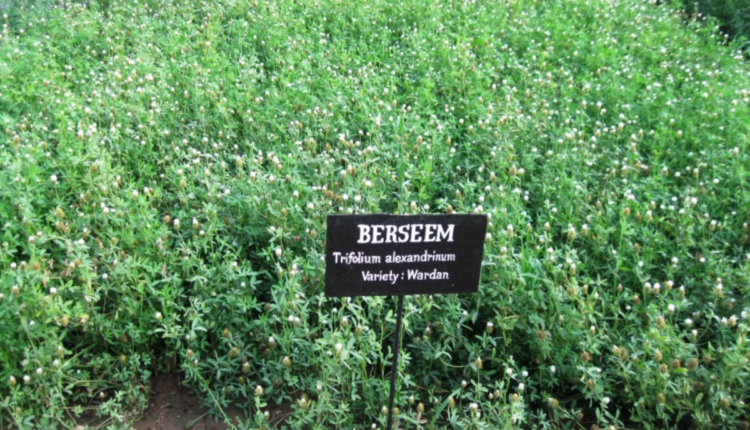Berseem Farming (Berseem Fodder Crop Production): Berseem is considered the best green fodder for dairy animals, because feeding it increases milk production. It is very nutritious, juicy, tasty and easily digestible, that is why it is also called the ‘King of Fodder’. Its crop is good in areas with good irrigation. In our country, Berseem is mostly cultivated in Punjab, Haryana, Delhi, Uttar Pradesh, Gujarat, Madhya Pradesh, Bihar, Maharashtra and Andhra Pradesh.
When is Berseem cultivated?
Berseem is suitable for cool climate. In this type of climate, Berseem is grown in winter and spring seasons in northern India. The optimum temperature for sowing and growth of Berseem is 25°C. Sowing time is important as it affects germination, number of harvests and production. The optimum sowing time is decided based on the temperature. Generally, sowing should be done when the temperature is 25°-27°C. In Punjab, Haryana, and Uttar Pradesh, the month of October is considered to be the suitable time for sowing. In Bengal and Gujarat, the crop can be sown in November.
Berseem Cultivation: Suitable Soil and Climate
Well drained clay and clay loam, rich in humus, calcium and phosphorus are considered suitable for Berseem cultivation. Berseem can also be grown in saline soil. It is advisable to do the first ploughing with a soil turning plough and the subsequent 2 or 3 ploughings with a Desi plough or cultivator. In the cultivation of this crop, the pH level of the soil should be between 7 to 8.
Improved Varieties of Berseem
Improved varieties of Berseem include many varieties like Berseem Ludhiana, Type-526, Type-678, Type-780, J.B.-1, J.B.-2, Miskawi, Pusa Giant, BL-180, Bundel-2, Vardaan, T-5 and T-26, JHP-1 -146, VL-22, U.P.V.-110, VL-10, VL-2, VL-1 and U.P.V.-103.
Pests and diseases affecting Berseem crop
Berseem contains many nutrients like protein, fiber, calcium, magnesium, phosphorus, sodium, so the health of animals remains good when it is used as fodder. Although the Berseem crop is not seriously affected by diseases, some fungal diseases have been identified, which reduce its yield potential to some extent.
Main pests in Berseem
White fly
It appears as a small insect with a yellow body covered with white waxy bloom when it is pupa-oval in shape and white waxy bloom when it is adult. When affected by it, chlorotic spots appear on the leaves and later the leaves turn yellow.
Pest management
To prevent white fly pest, adopt crop rotation with sorghum, ragi, maize etc.
Remove and collect the leaves affected by white fly from the plants, destroy all the leaves that have fallen due to pests.
For chemical management, use Acetamiprid 20 percent SP 100 g/hectare and Chlorpyrifos 20 percent EC 1250 ml/hectare.
Katua Moth
The larva of this insect is dark brown in colour with red head. Pupa is in soil cocoon. Caterpillar lives in soil at a depth of 2-4 inches. Caterpillars cut the plants at the base and bite the branches or stems of growing plants.
Pest Management
Plough the field deep in summer.
Adult insects can be controlled by light traps.
Under chemical management use Quinalphos 25 EC/1000 ml/ha and Profenophos 50 EC/1500 ml/ha.
Aphid
The abdomen of nymph and adult insect is dark coloured with conks. When infested, leaves of Berseem get covered with dark coloured aphids. Honeydew is secreted along with inflorescence stalk and adult pod and black ant.
Pest Management
Use Indoxacarb 15.8% SC 333 ml/hectare and 2% Neem oil.
Leaf Miner
The eggs of this insect are shiny white, the larvae have dark coloured heads and the adult insect is brown in colour. The adult larvae initially bore holes in the leaves. They feed on the mesophyll and form small brown spots on the leaves. The field appears ‘burnt’ when seen from a distance.
Pest Management
Use Dimethiate 30 EC 660 ml/hectare or Malathion 50 EC 1.25 litre/hectare.
Fungal diseases
Stem rot
This disease is caused by the fungus Sclerotinia sclerotiorum. Sclerotia of this fungus reach the field through machinery, animals, running water and seeds. The fungus attacks the root part of the stem and causes rotting.
Disease management
Use disease free crop seed.
Spray 0.1% solution of Bavistin twice in January and February at an interval of 15 days and avoid frequent irrigation.
Root rot
Root rot is a complex disease in berseem, which is caused by the three most common pathogenic fungi Rhizoctonia solani, Fusarium moniliforme and Sclerotinia bataticola. The first symptom of plant disease is that one or two branches of the plant wither and fall even under favorable conditions. Severe infestation of root rot disease reduces plant density and green fodder yield.
Disease Management
Crop rotation of 2-3 years and deep ploughing in summer. Seed treatment with Carbendazim 2 gm/kg seed.
Contact us- If farmers want to share any valuable information or experiences related to farming, they can connect with us via phone or whatsApp at 9599273766 or you can write to us at [email protected]. Through Kisan of India, we will convey your message to the people, because we believe that if the farmers are advanced then the country is happy.
You can connect with Kisan of India on Facebook, Twitter, and WhatsApp and Subscribe to our YouTube channel.



